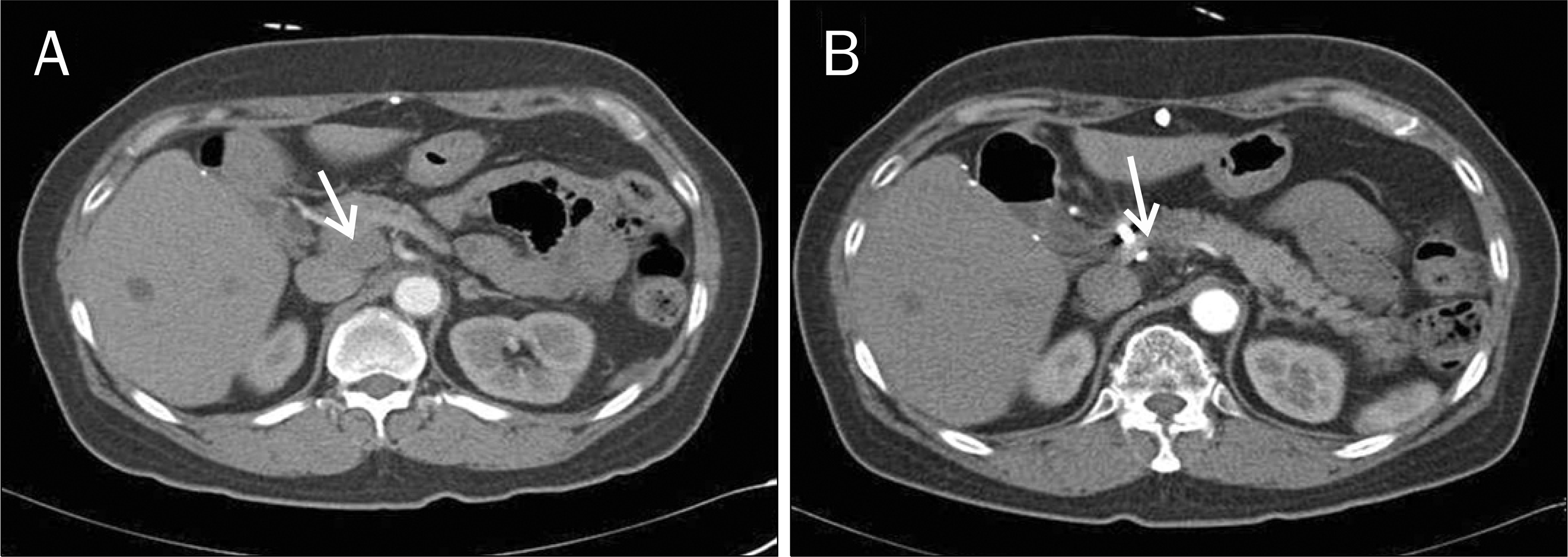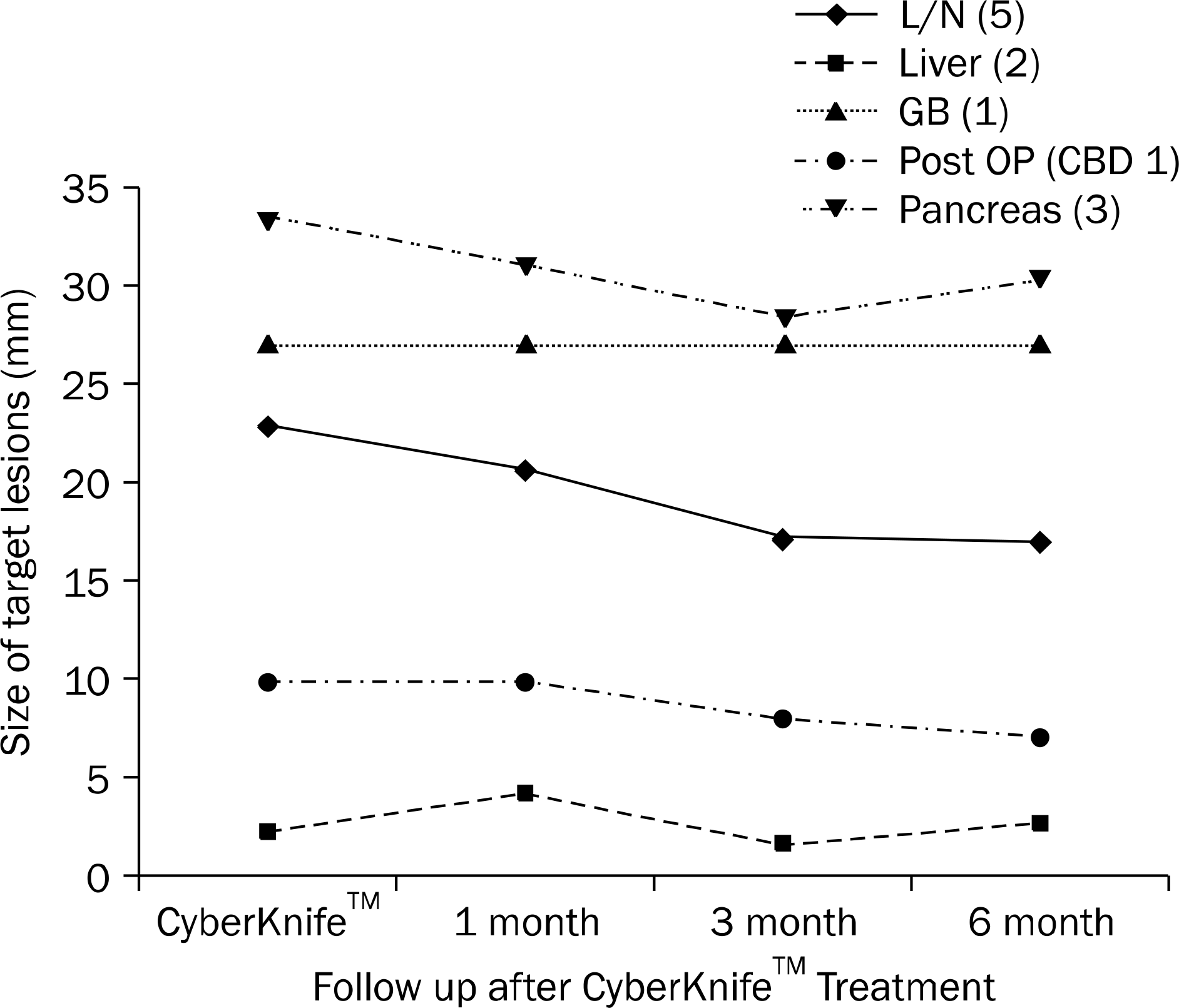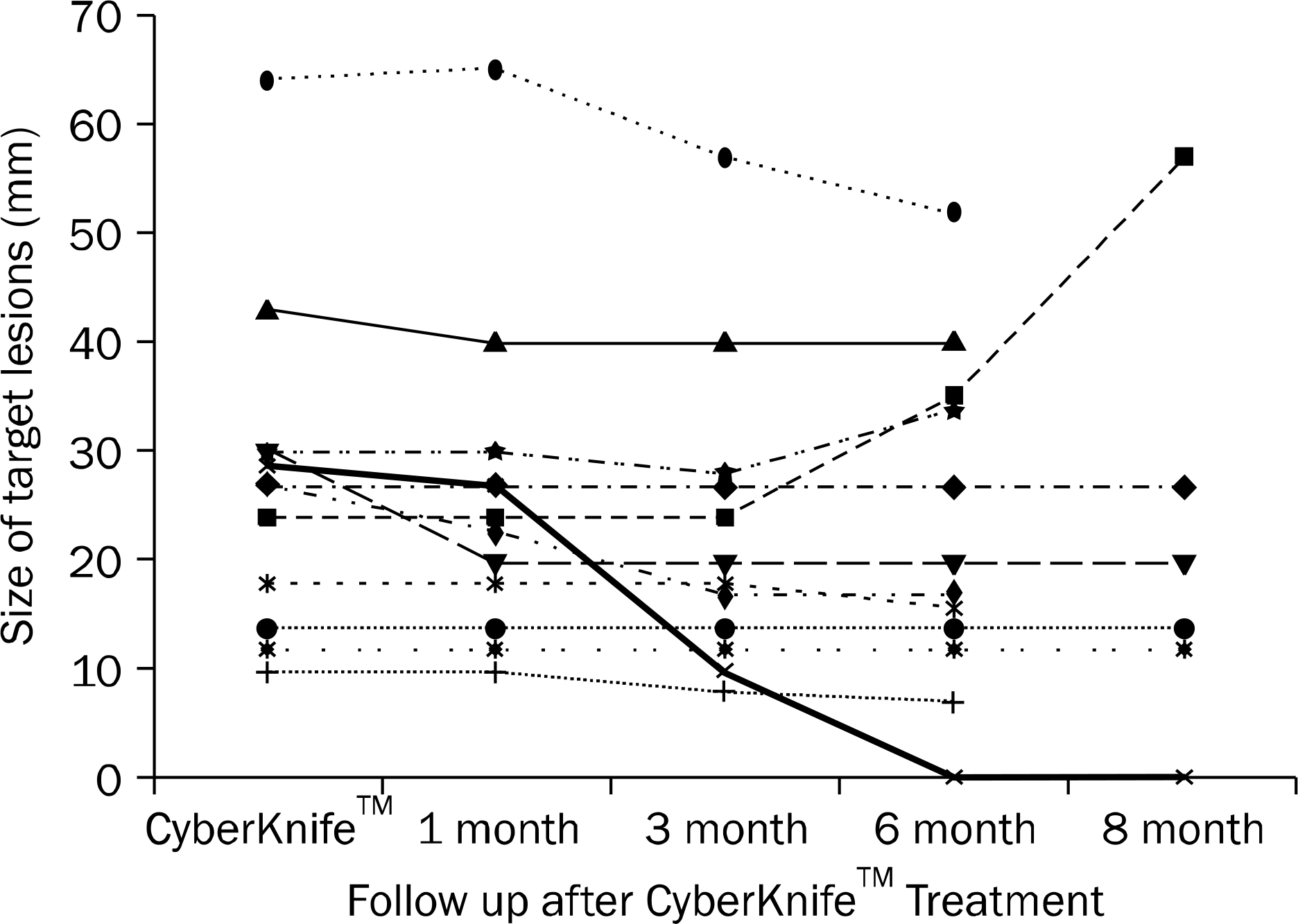Abstract
Background/Aims
CyberKnife TM stereotactic body radiotherapy (SBRT) has been thought as a promising treatment modality for inoperable or recurred pancreaticobiliary malignancies. But, clinical course of CyberKnife TM treatment have not been established yet, so we report the experience of CyberKnife TM treatment in 19 patients with recurred or advanced pancreaticobilliary malignancies.
Methods
Between July 2008 and May 2009, 19 patients (gallbladder cancer 4, common bile duct cancer 5, and pancreatic cancer 10) with recurred (12) and advanced pancreaticobiliary cancer (7) underwent CyberKnife TM treatment in Soonchunhyang University Hospital. Tumor size was evaluated at 1, 3, 6, 8 and every 3 months after SBRT.
Results
The mean age was 60.2 years, and the mean size of target lesions was 28.1±1.30 mm. After CyberKnife TM treatment, the average size of target lesions was decreased; 2.53±4.18 mm from months 0–1 in 19 patients, 2.47±4.7 mm from months 1–3 in 15 patients, 0.08±5.11 mm from months 3–6 in 12 patients. However, the average size of target lesions was increased 3.67±8.98 mm from months 6–8 in 6 patients. There were 2 cases of massive duodenal ulcer bleeding after CyberKnife TM treatment, one of them expired due to ulcer bleeding. Also, other minor complications appeared such as 1 case of abdominal pain and 1 case of diarrhea.
Conclusions
CyberKnife TM treatment seems to be effective in local control of pancreaticobiliary cancer, but we experienced serious complications. Further prospective studies will be needed for the proper evaluation of role of Cyberknife TM treatment in patients with advanced pancreaticobiliary malignancies.
Go to : 
References
1. Malhi H, Gores GJ. Review article: the modern diagnosis and therapy of cholangiocarcinoma. Aliment Pharmacol Ther. 2006; 23:1287–1296.

2. Khan SA, Thomas HC, Davidson BR, Taylor-Robinson SD. Cholangiocarcinoma. Lancet. 2005; 366:1303–1314.

3. Koorstra JB, Hustinx SR, Offerhaus GJ, Maitra A. Pancreatic carcinogenesis. Pancreatology. 2008; 8:110–125.

4. Ito Y, Okusaka T, Kagami Y, et al. Evaluation of acute intestinal toxicity in relation to the volume of irradiated small bowel in patients treated with concurrent weekly gemcitabine and radiotherapy for locally advanced pancreatic cancer. Anticancer Res. 2006; 26:3755–3759.

5. Tse RV, Hawkins M, Lockwood G, et al. Phase I study of individualized stereotactic body radiotherapy for hepatocellular carcinoma and intrahepatic cholangiocarcinoma. J Clin Oncol. 2008; 26:657–664.

6. Wulf J, Guckenberger M, Haedinger U, et al. Stereotactic radiotherapy of primary liver cancer and hepatic metastases. Acta Oncol. 2006; 45:838–847.

7. Kelsey CR, Schefter T, Nash SR, et al. Retrospective clinicopathologic correlation of gross tumor size of hepatocellular carcinoma: implications for stereotactic body radiotherapy. Am J Clin Oncol. 2005; 28:576–580.
8. Romanelli P, Chang SD, Koong A, Adler JR. Extracranial radiosurgery using the CyberKnife. Tech Neurosurg. 2003; 9:226–231.

9. Koong AC, Christofferson E, Le QT, et al. Phase II study to assess the efficacy of conventionally fractionated radiotherapy followed by a stereotactic radiosurgery boost in patients with locally advanced pancreatic cancer. Int J Radiat Oncol Biol Phys. 2005; 63:320–323.

10. Koong AC, Le QT, Ho A, et al. Phase I study of stereotactic radiosurgery in patients with locally advanced pancreatic cancer. Int J Radiat Oncol Biol Phys. 2004; 58:1017–1021.

11. Moore MJ, Goldstein D, Hamm J, et al. National Cancer Institute of Canada Clinical Trials Group. Erlotinib plus gemcitabine compared with gemcitabine alone in patients with advanced pancreatic cancer: a phase III trial of the National Cancer Institute of Canada Clinical Trials Group. J Clin Oncol. 2007; 25:1960–1966.

12. Heinemann V, Quietzsch D, Gieseler F, et al. Randomized phase III trial of gemcitabine plus cisplatin compared with gemcitabine alone in advanced pancreatic cancer. J Clin Oncol. 2006; 24:3946–3952.

13. Murphy MJ, Adler JR Jr, Bodduluri M, et al. Image-guided radiosurgery for the spine and pancreas. Comput Aided Surg. 2000; 5:278–288.

14. Romanelli P, Heit G, Chang SD, Martin D, Pham C, Adler J. Cyberknife radiosurgery for trigeminal neuralgia. Stereotact Funct Neurosurg. 2003; 81:105–109.

16. Schweikard A, Glosser G, Bodduluri M, Murphy MJ, Adler JR. Robotic motion compensation for respiratory movement during radiosurgery. Comput Aided Surg. 2000; 5:263–277.

17. Hovdenak N, Fajardo LF, Hauer-Jensen M. Acute radiation proctitis: a sequential clinicopathologic study during pelvic radiotherapy. Int J Radiat Oncol Biol Phys. 2000; 48:1111–1117.

18. Pradhan DG, Brown CH. Gastroduodenal morbidity of para-aort-ic and iliac lymph node irradiation using a single anterior 16 MV X-ray field. Clin Radiol. 1988; 39:438–441.

19. Flobert C, Cellier C, Landi B, et al. Severe hemorrhagic gastritis of radiation origin. Gastroenterol Clin Biol. 1998; 22:232–234.
20. Breiter N, Sassy T, Trott KR. The effect of dose fractionation on radiation injury in the rat stomach. Radiother Oncol. 1993; 27:223–228.

21. Chung YW, Han DS, Paik CH, et al. Localized esophageal ulcerations after CyberKnife treatment for metastatic hepatic tumor of colon cancer. Korean J Gastroenterol. 2006; 47:449–453.
22. Chang JH, Choi MG, You CR, et al. A case of acute injury in the stomach and duodenum after cyberknife therapy. Korean J Gastrointest Endosc. 2007; 35:262–266.
23. Choi JY. Experimental treatment of hepatocellular carcinoma. Korean J Gastroenterol. 2005; 45:271–276.
Go to : 
 | Fig. 1.CT findings. (A) CT scan revealed 2.9 cm sized metastatic lymph node in portocaval space (arrow). (B) Follow up CT scan after 6 months of CyberKnife TM therapy showed nearly complete resolution of metastatic lymph node (arrow). |
 | Fig. 3.Response related to target organ in 12 patients. L/N, lymph node; GB, gallbladder; Post OP, postoperative; CBD, common bile duct. |
Table 1.
Patient Characteristics




 PDF
PDF ePub
ePub Citation
Citation Print
Print



 XML Download
XML Download